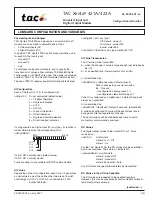
7
eFlex
Tile Adhesive
eGauge
Concrete sub floor
Screed
Tiles e.g. ceramic, marble,
slate, limestone etc
ePanel
insulation board
(optional)
eMesh
Timber subfloor
Warranty Validation
To validate your 15 year online warranty registration you must perform the insulation resistance
test, the heating cable resistance test, and the sensor resistance test three times during the
installation process.
1. Before you lay the eFlex.
2. After you have laid your eFlex and before you cover your eFlex.
3. After your finished floor has been laid.
This information must then be recorded on your commissioning record (enclosed within the box).
Floor Construction Examples
The eFlex is a loose laid cable which can be installed beneath most ceramic, porcelain/slate and natural stone tiles.
When using laminate, engineered timber or vinyl floors a flexible self levelling compound should be used.
Heating Cable Resistance Test
This test is carried out to prove continuity of the heating
element. A low resistance ohm meter should be used
(ie Multimeter on ohm setting), connect your meter on
to the black and blue mains lead and confirm resistance
value matches that quoted on your specification label
on the eFlex Cold Lead joint.
Floor Cable Resistance Test
See Heating Cable Resistance Test and repeat with floor
sensor cable.
Insulation Resistance Test
This test is performed to measure the insulation
resistance between conductors and ensures the cable
insulation is not damaged. A low resistance reading
indicates a damaged cable and must be repaired or
replaced.
The insulation resistance tester should be connected
between the conductors (blue and black cables)
and the earth cable. The meter should record a high
resistance value e.g. above 100 Meg ohms.
Testing & Commissioning and Floor Construction Examples


























